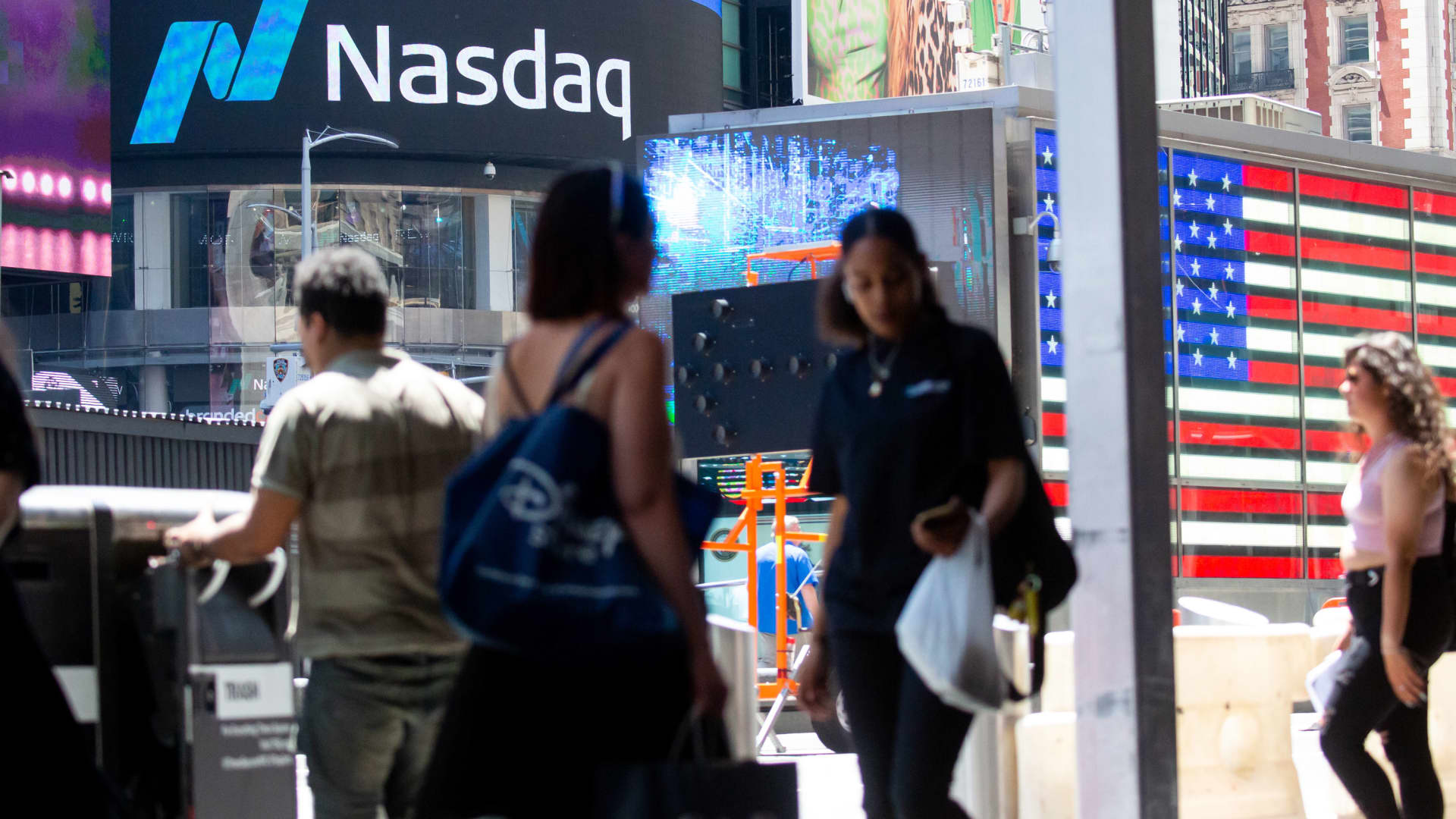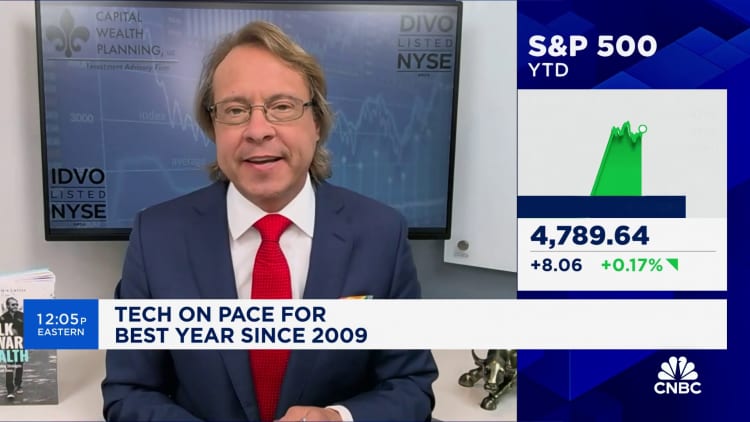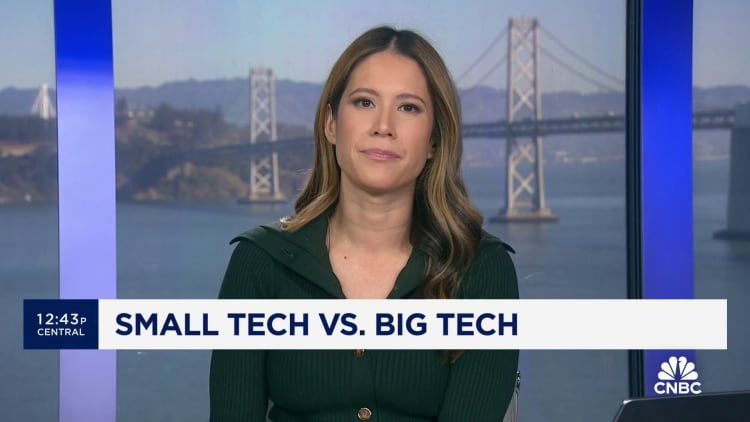
The Nasdaq MarketSite in the Times Square neighborhood of New York, on Tuesday, May 31, 2022.
Michael Nagle | Bloomberg | Getty Images
Tech stocks rebounded from a disastrous 2022 and lifted the Nasdaq to one of its strongest years in the past two decades.
After last year’s 33% plunge, the tech-heavy Nasdaq finished 2023 up 43%, its best year since 2020, which was narrowly higher. The gain was also just shy of the index’s performance in 2009. Those are the only two years with bigger gains dating back to 2003, when stocks were coming out of the dot-com crash.
The Nasdaq is now just 6.5% below its record high it reached in November 2021.
Across the industry, the big story this year was a return to risk, driven by the Federal Reserve halting its interest rate hikes and a more stable outlook on inflation. Companies also benefited from the cost-cutting measures they put in place starting late last year to focus on efficiency and bolstering profit margins.
“Once you have a Fed that’s backing off, no mas, in terms of rate hikes, you can get back to the business of pricing companies properly — how much money do they make, what kind of multiple do you put on it,” Kevin Simpson, founder of Capital Wealth Planning, told CNBC’s “Halftime Report” on Tuesday. “It can continue into 2024.”

While the tech industry got a big boost from the macro environment and the prospect of lower borrowing costs, the emergence of generative artificial intelligence drove excitement in the sector and pushed companies to invest in what’s viewed as the next big thing.
Nvidia was the big winner in the AI rush. The chipmaker’s stock price soared 239% in 2023, as large cloud vendors and heavily funded startups snapped up the company’s graphics processing units (GPUs), which are needed to train and run advanced AI models. In the first three quarters of 2023, Nvidia generated $17.5 billion in net income, up more than sixfold from the prior year. Revenue in the latest quarter tripled.
Jensen Huang, Nvidia’s CEO, said in March that AI’s “iPhone moment” has begun.
“Startups are racing to build disruptive products and business models, while incumbents are looking to respond,” Huang said at Nvidia’s developers conference. “Generative AI has triggered a sense of urgency in enterprises worldwide to develop AI strategies.”
‘Relatively early stages’
Consumers got to know about generative AI thanks to OpenAI’s ChatGPT, which the Microsoft-backed company released in late 2022. The chatbot allowed users to type in a few words of text and start a conversation that could produce sophisticated responses in an instant.
Developers started using generative AI to create tools for booking travel, creating marketing materials, enhancing customer service and even coding software. Microsoft, Google, Meta and Amazon touted their hefty investments in generative AI as they embedded the tech across product suites.
Amazon CEO Andy Jassy said on his company’s earnings call in October that generative AI will likely produce tens of billions of dollars in revenue for Amazon Web Services in the next few years, adding that Amazon is using the models to forecast inventory, establish transportation routes for drivers, help third-party sellers create product pages and help advertisers generate images.
“We have been surprised at the pace of growth in generative AI,” Jassy said. “Our generative AI business is growing very, very quickly. Almost by any measure it’s a pretty significant business for us already. And yet I would also say that companies are still in the relatively early stages.”
Amazon shares climbed 81% in 2023, their best year since 2015.
Microsoft investors enjoyed a rally this year unlike anything they’d seen since 2009, with shares of the software company climbing 58%.
In addition to its investment in OpenAI, Microsoft integrated the technology into products like Bing, Office and Windows. Copilot became the brand for its broad generative AI service, and CEO Satya Nadella described Microsoft last month as “the Copilot company.”
“Microsoft’s partnership with OpenAI and subsequent product innovation through 2023 has resulted in a market dynamic shift,” Michael Turrin, a Wells Fargo analyst who recommends buying the stock, wrote in a Dec. 20 note to clients. “Many now view MSFT as the outright leader in the early AI wars (even ahead of market share leader AWS).”
Meanwhile, Microsoft has been cranking out profits at a historic rate. In its latest earnings report, Microsoft said its gross margin exceeded 71% for the first time since 2013, when Steve Ballmer ran the company. Microsoft has found ways to more efficiently run its data centers and has lowered reliance on hardware, resulting in higher margins for the segment containing Windows, Xbox and search.
Microsoft CEO Satya Nadella (R) speaks as OpenAI CEO Sam Altman (L) looks on during the OpenAI DevDay event on November 06, 2023 in San Francisco, California. Altman delivered the keynote address at the first ever Open AI DevDay conference.
Justin Sullivan | Getty Images
After Nvidia, the biggest stock pop among mega-cap tech companies was in shares of Meta, which jumped almost 200%. Nvidia and Meta were by far the two top performers in the S&P 500.
Meta’s rally was sparked in February, when CEO Mark Zuckerberg, who founded the company in 2004, said 2023 would be the company’s “year of efficiency” after the stock plummeted 64% in 2022 due largely to three straight quarters of declining revenue.
The company cut more than 20,000 jobs, proving to Wall Street it was serious about streamlining its expenses. Then growth returned as Facebook picked up market share in digital advertising. For the third quarter, Meta recorded expansion of 23%, its sharpest increase in two years.
Where are the IPOs?
Like Meta, Uber wasn’t around during the dot-com crash. The ride-hailing company was founded in 2009, during the depths of the financial crisis, and became a tech darling in the ensuing years, when investors favored innovation and growth over profit.
Uber went public in 2019, but for a long time battled the notion that it could never be profitable because so much of its revenue went to paying drivers. But the economic model finally began to work late last year, for both its rideshare and food delivery businesses.
That all allowed Uber to achieve a major investor milestone earlier this month, when the stock was added to the S&P 500. Members of the index must have positive earnings in the most recent quarter and over the prior four quarters in total, according to S&P’s rules. Uber reported net income of $221 million on $9.29 billion in revenue for its third quarter, and in the past four quarters altogether, it generated more than $1 billion in profit.
Uber shares climbed to a record this week and jumped 149% for the year. The stock, which is listed on the New York Stock Exchange, finished the year as the sixth-biggest gainer in the S&P 500.
Despite the tech rally in 2023, there was a dearth of new opportunities for public investors during the year. After a dismal 2022 for tech IPOs, very few names came to market in 2023. The three most notable IPOs — Instacart, Arm and Klaviyo — all took place during a one-week stretch in September.
For most late-stage companies in the IPO pipeline, more work needs to be done. The public market remains unwelcoming for cash-burning companies that have yet to show they can be sustainably profitable, which is a problem for the many startups that raised mountains of cash during the zero-interest days of 2020 and 2021.
Even for profitable software and internet companies, multiples have contracted, meaning the valuation startups achieved in the private market will require many of them to take a haircut when going public.
Byron Lichtenstein, a managing director at venture firm Insight Partners, called 2023 “the great reset.” He said the companies best positioned for IPOs are unlikely to debut until the back half of 2024 at the earliest. In the meantime, they’ll be making necessary preparations, such as hiring independent board members and spending on IT and accounting to make sure they’re ready.
“You have this dynamic of where expectations were in ’21 and the prices that were paid then,” Lichtenstein said in an interview. “We’re still dealing with a little bit of that hangover.”
—CNBC’s Jonathan Vanian contributed to this report
WATCH: Rate-sensitive tech stocks making a comeback







